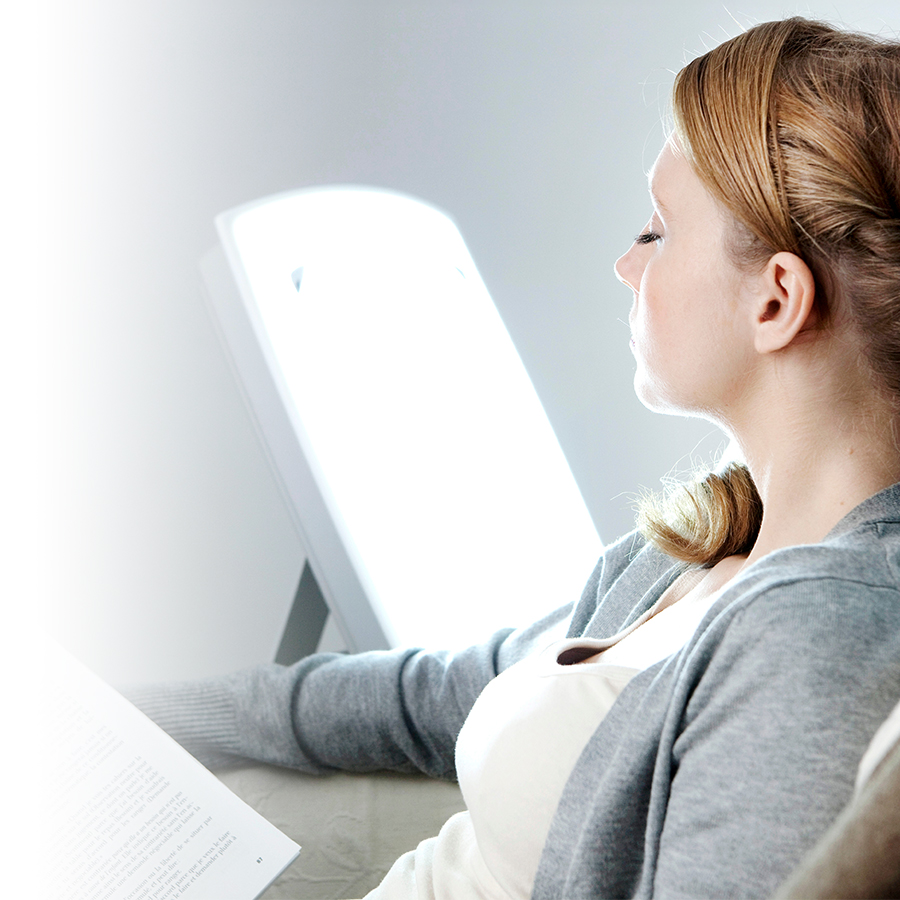When winter arrives and the sunlight diminishes, a light therapy lamp can help you fight the effects of seasonal affective disorder (SAD). Read on to discover these lamps and get a few good pointers on how to choose the right one so you can enjoy the many benefits of light therapy.
What is light therapy?
Light therapy, also known as phototherapy, is a non-medicinal treatment with proven effectiveness at reducing the effects of diminished light in people who suffer from seasonal affective disorder. Specifically, it’s a completely natural method that works by reducing your body's levels of melatonin (the hormone that affects sleep) during daytime, while exerting a positive influence on your body’s circadian rhythm (the internal clock that regulates your waking and sleeping cycles) by reproducing the effects of natural sunlight. Light therapy also acts on the production of serotonin (one of the hormones responsible for feelings of happiness), a chemical produced by the brain to help regulate your moods and sleep patterns.
Light therapy is especially recommended for people who tend to suffer from seasonal affective disorder or winter blues, or for people who want to fight the insomnia caused by lack of sunlight in winter.
Did you know?
It’s estimated that approximately 18% of Canadians are affected by the lack of sufficient sunlight in winter.
What are the benefits of a light therapy lamp?
Light therapy is generally an effective way to help fight the effects of diminished sunlight by exposing you to daily artificial light that reproduces the benefits of natural sunlight.
The result? Better sleep, better moods and more energy, to name but a few.
When to use a light therapy lamp?
For most people, light therapy treatment should begin in the early fall, when the amount of sunlight begins to decrease, and continue until spring. If you're unsure, you should speak to your pharmacist for recommendations on the type or amount of light therapy that’s right for you.
What is the ideal duration of a light therapy session?
The recommended amount of exposure to a light therapy lamp varies depending on the lamp’s intensity. For example, a lamp that produces 10,000 lux (the unit of measurement for light intensity) should be used for approximately 30 minutes a day, but a lamp with lower intensity requires a longer exposure. It’s best to use your lamp in the morning, and always at the same time, to control your circadian rhythm and signal to your body that it’s time to become more active.
Where and how to position your light therapy lamp?
For most people, a light therapy lamp should be placed about 30 to 60 cm from your face, and slightly above eye level, so the light penetrates your eyes, without you having to look directly into the light.
Position your lamp so its field of exposure is wide enough to give you a certain freedom of movement while you’re being exposed to the light. You should be able to carry on your usual activities, like reading, working, watching TV, eating, etc., while still receiving the optimal level of exposure to the lamp.
When will you feel the benefits?
Results can usually be felt within the first week of light therapy, but four weeks of treatment is usually required before you feel the optimal benefits.
Which light therapy lamp to choose?
Thinking about purchasing a light therapy lamp? Keep these helpful tips in mind:
- The cost of the lamp can be quite high (often $200 or more), so shop around and ask about the features of the different models before you buy.
- The intensity of the available lamps can vary from 2,500 to 10,000 lux. The higher the lux, the shorter the treatment time. For example, you might only need 30 minutes with a 10,000-lux lamp vs 60 minutes with one that emits 5,000 lux. So, choose accordingly.
- Choose a model that suits your lifestyle and the room you’ll most often be using it in. Models of lamps include standing, tabletop, desktop, portable, etc.
- Make sure the field of light is wide enough, so you’re not restricted to a small area during exposure. By doing that, you’ll be able to carry out your daily activities like reading, working, watching tv, eating, etc., while ensuring your face absorbs the right amount of light.
- Find out if your medical insurance covers the cost of a light therapy lamp. In many cases, a doctor's prescription may be required.
Where to buy a light therapy lamp?
Your pharmacy has several types of lamps to choose from. Feel free to ask your pharmacist about which type is best for your situation and needs. They can also provide you with other ways to help fight the symptoms of SAD and while maintaining optimal health in winter.

